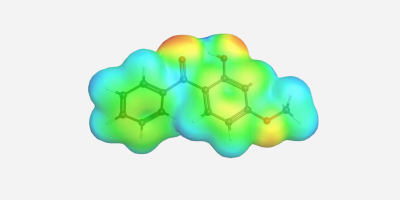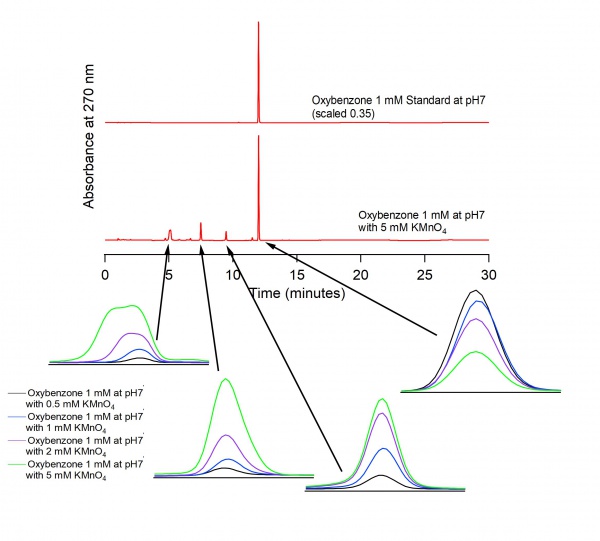Difference between revisions of "Oxybenzone Research Paper"
| (15 intermediate revisions by the same user not shown) | |||
| Line 1: | Line 1: | ||
| + | ==Abstract== | ||
| + | Oxybenzone is an ingredient used to protect against UV exposure in some sunscreens. The oxidation of this bio phenol can create a stressful environment for coral reefs, causing coral bleaching and other adverse effects on the environment. The oxidation of oxybenzone has been explored through chemical (KMnO_4) and enzymatic (peroxidase) oxidation reactions. HPLC data is presented. | ||
| + | |||
==Introduction== | ==Introduction== | ||
| + | |||
| + | Sunscreen is made to protect humans, but in some cases can harm the environment. Oxybenzone, also known as benzophenone-3, is one of these sunscreen ingredients that has proven to be harmful to the environment, more specifically the ocean. This compound has a variety of effects on marine life such as preventing reproduction of fish and coral and can even lead to fish and coral mortality. Oxybenzone can also have the same effect on algae which is one of the main sources of oxygen on earth. This death of the algae can result in coral bleaching. Coral bleaching is when the algae living on the coral are destroyed, leaving the coral to starve. Not only has oxybenzone been found in the fish humans eat, but it has also been found in human urine and various waterways. For these reasons, sunscreens containing oxybenzone are often banned from use in areas with coral and other susceptible marine life. | ||
| + | Oxybenzone can go through many different reactions in order to cause such adverse effects. For example, the chlorination of oxybenzone is common in swimming pools and wastewater treatment plants and can produce toxic byproducts. Due to the fact that the structure of oxybenzone has a phenol, the compound can be oxidized. | ||
| + | |||
| + | Oxidations of phenols can happen through several types of oxidation methods, but this paper focuses on the enzymatic and chemical oxidations. Peroxidases can catalyze the reaction of the decomposition of hydrogen peroxide into water and oxidation products in the presence of a substrate, which increases the decomposition rate. Horseradish peroxidase was used in attempts to oxidize oxybenzone. After this, chemical oxidation using potassium permanganate was completed. The High Pressure Liquid Chromatography (HPLC) data shows that there are main products formed from the reaction with the substrate and potassium permanganate. | ||
| + | |||
| + | [[File:oxybenzone_electrostatic_potential.png|400px|thumb|left|Figure 1. Electrostatic potential map of oxybenzone showing the concentration of electrons around the alcohol group.]] | ||
| + | |||
| + | |||
| + | |||
| + | |||
| + | |||
| + | |||
| + | |||
| + | |||
| + | |||
| + | |||
| + | |||
| + | |||
| + | |||
| + | |||
| + | |||
| + | |||
| + | |||
==Methods/Safety/Instrumentation== | ==Methods/Safety/Instrumentation== | ||
| Line 7: | Line 34: | ||
[[File:posterpicture_research.jpg|600px|thumb|left|Figure 3. Representation of the Oxidation of Oxybenzone and Oxidation Products.]] | [[File:posterpicture_research.jpg|600px|thumb|left|Figure 3. Representation of the Oxidation of Oxybenzone and Oxidation Products.]] | ||
| + | |||
| + | |||
| + | |||
| + | |||
| + | |||
| + | |||
| + | |||
| + | |||
| + | |||
| + | |||
| + | |||
| + | |||
| + | |||
| + | |||
| + | |||
| + | |||
| + | |||
| + | |||
| + | |||
| + | |||
| + | |||
| + | |||
| + | |||
| + | |||
| + | |||
| + | |||
| + | |||
| + | |||
| + | |||
| + | |||
| + | |||
| + | |||
| + | |||
| + | |||
| + | |||
| + | |||
Latest revision as of 23:09, 26 April 2020
Abstract
Oxybenzone is an ingredient used to protect against UV exposure in some sunscreens. The oxidation of this bio phenol can create a stressful environment for coral reefs, causing coral bleaching and other adverse effects on the environment. The oxidation of oxybenzone has been explored through chemical (KMnO_4) and enzymatic (peroxidase) oxidation reactions. HPLC data is presented.
Introduction
Sunscreen is made to protect humans, but in some cases can harm the environment. Oxybenzone, also known as benzophenone-3, is one of these sunscreen ingredients that has proven to be harmful to the environment, more specifically the ocean. This compound has a variety of effects on marine life such as preventing reproduction of fish and coral and can even lead to fish and coral mortality. Oxybenzone can also have the same effect on algae which is one of the main sources of oxygen on earth. This death of the algae can result in coral bleaching. Coral bleaching is when the algae living on the coral are destroyed, leaving the coral to starve. Not only has oxybenzone been found in the fish humans eat, but it has also been found in human urine and various waterways. For these reasons, sunscreens containing oxybenzone are often banned from use in areas with coral and other susceptible marine life. Oxybenzone can go through many different reactions in order to cause such adverse effects. For example, the chlorination of oxybenzone is common in swimming pools and wastewater treatment plants and can produce toxic byproducts. Due to the fact that the structure of oxybenzone has a phenol, the compound can be oxidized.
Oxidations of phenols can happen through several types of oxidation methods, but this paper focuses on the enzymatic and chemical oxidations. Peroxidases can catalyze the reaction of the decomposition of hydrogen peroxide into water and oxidation products in the presence of a substrate, which increases the decomposition rate. Horseradish peroxidase was used in attempts to oxidize oxybenzone. After this, chemical oxidation using potassium permanganate was completed. The High Pressure Liquid Chromatography (HPLC) data shows that there are main products formed from the reaction with the substrate and potassium permanganate.
Methods/Safety/Instrumentation
Results


